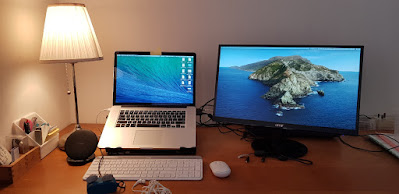 |
| My personal setup for online meetings, classes, and webinars. Copyright Albert Causo 2020. |
Everything is moving to online these days including classes and meetings. I actually appreciate this as it saves time and money. Don't get me wrong though, I know the value of face to face meetings. But most of the time, online meetings should suffice.
My pet peeves during online meetings include dark video, spotty microphone, and spotty internet connection. These problems when solved will improve the meeting experience for every participant.
So here's my list of the hardware tech setup needed to run online meetings successfully, based on my experience.
- Computer or laptop
- Doing online meetings from a mobile phone is not advisable, especially since people on mobile tend to be moving around in a noisy environment.
- Internet connection
- Ensure that you have a good connection! Mobile internet using your phone may not provide the best connectivity unless you use the wifi mode.
- At home, ensure that your computer has a good wifi connection. Consider plugging your computer/laptop to your router using an ethernet cable or invest in an extender or mesh. It doesn't matter if you have gigabit service from your telco if your computer has a spotty connection to your router.
- Camera
- Most laptops have cameras. Just make sure they are clean and angled properly. You may want to put a post-it on it when not in use for extra security.
- Webcams are enough. No need to use high-resolution or professional cameras. In fact, a high-resolution camera can choke a low-bandwidth internet connection. Plus, you would not want all those facial blemishes appearing prominently on the screen.
- Microphone & Speaker
- Laptops have a built-in mic and speaker. Use them especially if they are of good quality.
- Invest in a good mic/speaker. If possible consider ones with noise-cancelling feature. Wireless (mostly Bluetooth) headsets are good if you need to move around during your meetings. It's very helpful for long meetings although battery life can limit the duration of use.
- For comfort, consider over-the-ear instead of on-ear or in-ear headsets. Over-the-ear covers your whole ear and is very comfortable. On-ear is cheaper but it rests on your ear while in-ear is the small ones you insert in your ears. It looks good and very futuristic but can be uncomfortable with long use like the on-ear.
- Bluetooth headphones, even the noise-cancelling ones, tend to have 2 issues which create a grating experience to the other parties --
- Their mics are sensitive and tend to pick the smallest annoying sound like the whirring and whooshing of an electric fan. Turn off these sources of sound when using this kind of headset/mic. Do not stir a glass of juice with lots of ice or coffee in a metal mug using a metal spoon as the high-pitched banging gets amplified over the mic.
- When Bluetooth connection is not proper, the spotty connection between your computer/phone and the headset creates a lot of static noise. Reset your phone/computer and its connection to your headset. If it is still there, consider using a wired connection instead.
- Two more notes --
- I have a wired headset, the one that comes with mobile phones, as a back up in case my wireless headset does not work for some reason. It is not ideal but sound connectivity is a priority over convenience.
- If you are in a noisy room, consider putting your mic in mute at all times except when you need to speak. Your meeting mates will thank you for being considerate.
- Lighting
- If your laptop or monitor is close enough to your face, you may not need this. However, your camera will be all chin and nose (or forehead and eyes) if you are too close to your camera.
- But consider putting a light source in front of you, preferably beside or behind the camera position. A desk lamp or a study lamp directed at your face is usually enough. Ring lamps are okay but they tend to be expensive and it could block your view of your computer monitor.
- If you need your whole body to be shown on-screen (sometimes needed for online classes or webinars), consider turning on the ceiling light and adding a few lamps around the room to increase the ambient light and illuminate your whole body. Again, it might be best to put the lamp in front of you behind the camera for optimum lighting.
- Two notes on lighting --
- Consider using warm lamps instead of fluorescent or white lights as you will appear ashen on screen. A warm lamp (similar to a light bulb) gives you a nice glowing tone on-screen.
- Do not direct or point the light source at your face or you will appear with a bright spot on-screen. It is best to have diffused lighting, which is why I recommend a desk lamp, which usually has a skirt that diffuses the light. A ring lamp scatters the light in a radial manner so you do not get a very bright nose.
- Extra screen
- This is entirely optional but would help a lot. It is usually an extra monitor connected to your computer or laptop via HDMI or VGA cable,
- This screen helps you to see your meeting mates or students on another monitor while your computer's main screen has the call app with controls and your camera view. Shared presentations can also be shown on the extra screen,
- If needed, you can use a big TV or even a projector, if you need to see all of your 45 students all at once.
These are my tried and tested hardware setup advice for online meetings, webinars, or classes. I have advice on do's and don't's during online meetings but that's for another time.
/first appeared on acauso.com
